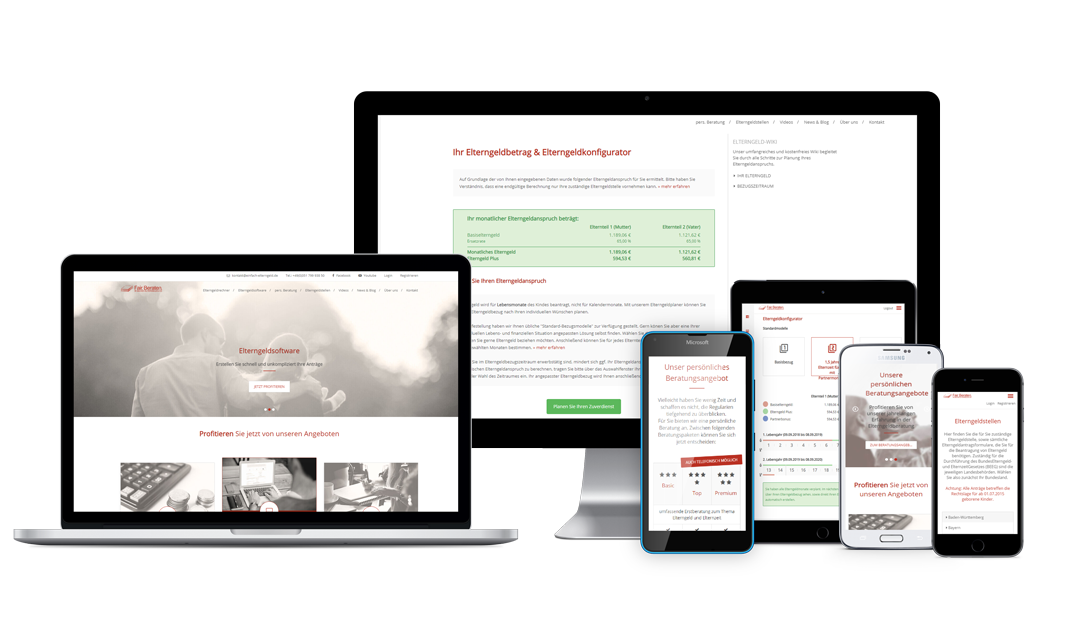
Parental allowance maximum rate
21.05.2021
Parental allowance is a federal allowance that replaces prenatal income. In this context, parents receiving basic parental allowance at a minimum of €300, but a maximum of €1,800 per month of life of the baby.
Response: Parents whose average prenatal net-income exceeds the amount of 2,770€ will receive the parental allowance maximum of currently 1,800€. However, this specific net-income is not the net-income you find on your pay slip or on your tax statement. The calculation of the "parental allowance net" is complex and is explained in detail in this article.
Basic parental allowance / parental allowance plus maximum rate easy to calculate yourself
Our free parental allowance calculator helps you to quickly and easily calculate your parental allowance entitlement.
How do I reach the maximum amount?
Parental allowance replaces a prenatal reference income. The parental allowance authority calculates an average income from a 12-month period before the birth (also called the reference period). The parental allowance-relevant income from these months is added together and divided by 12 to reach the monthly average.
Salaried employees
For salaried employees, only the regular and flat-rate taxed salary counts, that means one-time payments, other payments and tax-free salary components do not count here.
In the next step, the parental allowance office deducts lump sums for social security contributions from the average gross income. If you are compulsorily insured, this would be 21% of your gross income (10% for pension insurance, 9% for health and nursing care insurance and 2% for unemployment insurance contributions).
In addition, taxes are deducted according to your income tax class. The tax class that counts here is the one that you had predominantly in the reference period. We explain which tax class counts for you in the article "Parental allowance and tax class".
The resulting net income is the parental allowance net income, which is partially replaced in the form of the parental allowance. If it is greater than or equal to 2,770€, you will receive the maximum amount.
Example:
In this case, the parental allowance is 1,577€ (2,427€ x 65%).
Example in maximum amount:
The parental allowance in this case is 1,800€ (2,915€ > 2770€ x 65%).
Hinweis:
Aufgrund der Geburt eines Kindes weit vor dem errechneten Termin verlängert sich in aller Regel der Mutterschutz. Mütter, die in diesen Fällen Mutterschaftsgeldleistungen (bspw. von ihrer Krankenkasse, Arbeitgeber, etc.) erhalten, müssen für sämtliche Lebensmonate des Kindes, in denen sie Mutterschaftsgeld beziehen, Basiselterngeld beantragen. Das Mutterschaftsgeld wird dabei auf den Basiselterngeldanspruch angerechnet.
Conclusion:
In order to reach the parental allowance maximum amount as an employee, there are several "adjusting screws". On the one hand, it is logical to achieve the highest possible gross income, on the other hand, you can get a lot out of the deductions for social insurances and taxes, if you have optimization possibilities in this regard, e.g. in the form of a tax class change.
How employees can increase their gross income relevant to parental allowance is explained in our article "Increasing parental allowance".
Self-employed
In the case of self-employed persons, the taxable profit within the meaning of Section 4 (1) or (3) EStG counts, i.e. the annual surplus according to the profit and loss account of the balance sheet or the surplus of income over operating expenses a revenue surplus account. The annual profit is divided by 12 to obtain a monthly average.
In the next step, the parental allowance authority deducts lump sums for social security contributions from the average profit. If you are compulsorily insured, this would be 21% of the gross (10% for pension insurance, 9% for health and nursing care insurance and 2% for unemployment insurance contributions. Self-employed persons are in some cases exempt from the statutory social insurance obligation and can, for example, make private provision, participate in voluntary statutory insurance or be a member of a professional pension scheme.
In addition, taxes are deducted at a flat rate for self-employed persons according to tax class 4. There is no option here.
The resulting net income is the parental allowance net income, which is partially replaced in the form of the parental allowance. If it is greater than or equal to 2,770€, you will receive the maximum amount.
Example:
The parental allowance in this case is 1,184€ (1,822€ x 65%).
From the parental allowance, the self-employed must continue to pay the voluntary, or private pension insurance in all rule, please inform you in time at your insurance carrier, so as not to be surprised here.
Example in the maximum amount:
The parental allowance in this case is 1,800€ (2,821€ > 2770€ x 65%).
Conclusion:
The calculation basis for self-employed persons is the taxable profit. You can influence this together with the tax advisor. The tax office does not "force" you, for example, to declare business expenses or income can also sometimes be shifted to another calendar year by certain accounting, insofar the profit optimization with regard to the parental allowance is very worthwhile, but the corresponding tax burden should be kept in mind with the tax advisor.
Caution with additional earnings
The parental allowance law is unfortunately very unfair in some parts. Parents who are entitled to the maximum amount are hit particularly hard if they choose parental allowance with additional earnings. The problem is that here the real loss of earnings is not replaced proportionally (as the parental allowance system actually provides for), but the cap of the prenatal comparative income of €2,770 remains in place.
This makes additional earnings less worthwhile for parents at the maximum amount than for parents who earned below the net comparative income of €2,770. It is less and less worthwhile the higher the real parental allowance net is away from the 2,770€.
Example "not in the maximum amount":
Example " in maximum amount":
Actually, the loss of earnings would be 1,155€, the parental allowance claim therefore 750€. In the example case, parents "lose" 100€ in parental allowance each month due to the maximum amount cap.
This effect is even more serious in the following scenario:
In this situation, one only receives the minimum amount because no loss of earnings occurred compared to the prenatal net, whereas the parental allowance entitlement should actually be 866€ (4,608€ - 3,275€ = 1,333€ x 65%).
Conclusion:
In particular, high earners should pay particular attention to parental allowance with additional earnings, so that it will not come to unwanted repayment obligations. This can, especially with these amounts very quickly become very expensive.
The regulations on parental allowance can be very confusing in places. Parents want to be as financially secure as possible for the time after the birth, which is why we recommend our consulting services, where we calculate your parental allowance and show you your options:
Generate your parental allowance and child benefit applications quickly and easily with our own developed software:

With our parental allowance software, you can have your parental leave application filled in fully automatically!
Quick to use and easy to explain
No subscription - once 24,95 €
Detailed advice with own wiki
Available on all current internet browsers
Learn moreToo complicated? - Our tip
The parental allowance rules can be complicated. Make it easy and, like many other parents, use our services to get the most out of your parental allowance. We offer you many possibilities to make your application for parental leave as easy and uncomplicated as possible:
Parental Allowance Course Parental Money Software Personal Consultation